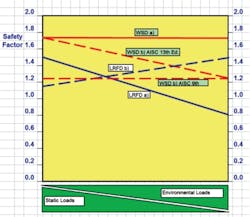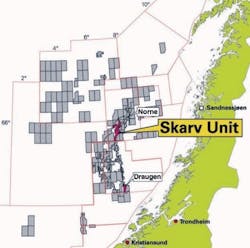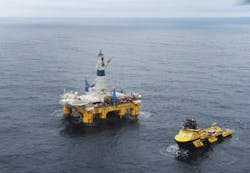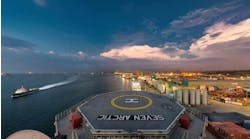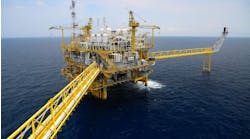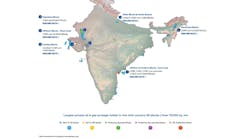Recently developed products and services aim to help offshore operators boost reserves and increase recovery rates
Bruce Beaubouef
Managing Editor
Contractors, vendors, and service and supplies companies introduced a range of new products and technologies at the 2011 Offshore Technology Conference held at the Reliant Park in Houston in early May.
The new technologies aim to help oil and gas companies operating in offshore regions boost oil and gas reserves, increase recovery rates, and locate new fields.
A number of these new technologies and services received OTC Spotlight Awards, in recognition of unique properties or designs, or potential benefits to the industry.
Drilling technologies
A number of new offerings were on display for the offshore drilling market. Among these was Halliburton’s CleanWave water treatment service. The service treats flowback and produced water to make it suitable for reuse in fracturing fluids or other drilling and production processes. The CleanWave unit is based on electrocoagulation and is designed to remove suspended solids, oil, other insoluble organics, and bacteria from the water.
Also on display was Baker Hughes’ Kymera hybrid drilling technology. The company says the new technology offers a fusion of roller-cone and PDC bits. Reducing costs with the cutting superiority and continuous scraping of diamond bits and the strength of roller-cones, the bit offers a lower and more consistent drilling torque, better dynamics and directional control, improved durability and reliability, and less torsional vibration.
Canrig featured its SureGrip ball-and-pocket gripping technology. This uses spherical balls in tapered pockets to replace die slips and thereby minimize handling impact, leaving pipe in its most robust condition. Accommodating increasingly heavier loads while minimizing resultant pipe yielding from handling, Canrig says, can change how pipe is handled in the offshore oil and gas industry.
Schlumberger introduced its SonicScope multi-pole sonic-while-drilling service. A new logging-while-drilling (LWD) service, SonicScope provides multi-pole measurements to consistently and reliably deliver compressional and shear data in all environments. Schlumberger says SonicScope is the only service with a dedicated mode for acquiring Stoneley waveforms while drilling.
Reelwell showcased its multi-gradient system. This uses a high-density fluid in the wellbore annulus above the bottomhole assembly, and a lighter active circulating fluid to enable MPD operations with zero surface pressure in the well annulus. Benefits include safer drilling, reduced cost, and increased horizontal reach.
National Oilwell Varco showcased its ShearMax low force casing shear rams, which expands the capabilities of pressure control equipment to reliably shear tool joints as well as casing. Tool joints up to XT-69 are sheared without exceeding the operator’s safe working design envelope, says Varco.
T3 Energy Services, a unit of Robbins & Myers Inc., introduced its new T3 SAR (Shear All Ram) system to address the challenges presented by the continuing evolution in drill pipe and extreme drilling programs. The SAR was designed to shear virtually all drill pipe and casing in the toughest drilling environments. T3 says the SAR blade geometry has been tested successfully against a range of drill pipe and casing sizes, regardless of pipe position in the wellbore.
Production and operations
Exhibitors also featured a number of new products and services for the offshore production and operations market. Baker Hughes highlighted its GeoForm conformable sand management system. GeoForm is an advanced open-cell shape memory polymer product for sand control. The company says the system provides a totally conformable sand control solution that reduces rig time along with personnel and HSE exposure without the need for pumping a gravel pack.
MyCelx displayed its new clean water technology system, an oil/water separation application designed to remove low-level hydrocarbons and WSOs from produced water. Units range in size from 1,000 b/d to 250,000 b/d and can either stand-alone or be retrofitted into any treatment train to ensure oil in water discharge between 0 and 10 ppm.
PG Pump Solutions and Techni introduced their PG-MAPS pumping system to OTC attendees. The device is designed as a compact, light weight and cost effective pumping system for all liquids. It uses a software-controlled, linear actuating system with permanent magnet motor. It features subsea/topside PD liquid pump; hermetical sealing for reduced emissions; high pressure and capacity; and no subsea/topside VSD.
Service companies also introduced new applications for floating production facilities. SBM Offshore featured what it says is the world’s first high voltage electrical AC swivel for turret moored FPSOs and floating power generation units. The HV AC Swivel, which received an OTC Spotlight Award, allows offshore producers to transfer high voltage electric power from shore to FPSOs (thereby reducing CO2 emissions) or from FPSOs to subsea equipment (leading to capex and opex savings).
Exhibitors also featured new technologies for the growing LNG market. SBM Offshore was active on this front, displaying what it says is the world’s first flexible cryogenic floating hose for the offshore transfer of LNG. The cryogenic offshore offloading and loading (COOL) hose is said to allow offshore LNG producers to reliably and safely offload LNG from an FLNG vessel to an LNG carrier.
Subsea
New technologies were also on display at OTC for the subsea market. Schilling Robotics and FMC Technologies Inc. featured their HD ROV, which they say provides increased reliability and availability through an integrated design philosophy for all major subsystems. This drives a significant reduction in components, enables modular maintenance, and reduces repair times to 60 minutes or less. The HD ROV also provides industry-leading accuracy for performing remote intervention.
The second generation Cameron DC all-electric subsea production system with the first-ever electric subsurface safety valve from Halliburton also debuted at OTC 2011. Cameron said the new system builds on its experience with all-electric subsea systems and features:
- State-of-the-art communications. The new system uses fiber-optic cables to increase the data transmission rate through an open-architecture that is plug-and-play ready.
- Improved functionality. The second generation system doubles the available functions from 16 to 32 possible. This means fewer modules and less power consumption.
- Cost comparison. This simplified architecture and improved functionality serve to make the cost of the all-electric system competitive.
The Halliburton all-electric subsurface safety valve has the electric actuator and controller within the valve and features redundant, independent actuation plus a mechanical fail-safe, said the company. The new valve is based on Halliburton’s magnetic and deepwater safety valve technology.
Viper Subsea showcased its new V-LOCK hydraulic stab plate, a subsea hydraulic connector providing a critical function in subsea control distribution systems. Viper says the device was developed following consultation with first tier suppliers, end users and installation contractors, and is designed to meet the demands of the subsea industry for the foreseeable future. It also notes that the V-LOCK offers leading clamping and separation force, and the secondary release system is positively actuated with no reliance on any form of shearing mechanism.
Magma Global Ltd. introduced m-pipe, a high-performance carbon and polymer pipe developed in response to the challenges of deepwater and dynamic subsea applications.
Magma Global Ltd. introduced m-pipe, a high-performance carbon and polymer pipe developed in response to the challenges of deepwater, sour service, high-pressure/high-temperature, and highly dynamic subsea applications. The company says m-pipe improves reliability, increases performance, and has a longer life than conventional un-bonded flexible pipes or steel solutions. With internal diameters between 2 in. and 24 in., m-pipe can be produced in continuous lengths through Magma’s highly automated and controlled manufacturing process. Pipe diameters up to 15-in. can be spooled for storage, transport, and subsequent deployment.
Offshore Articles Archives
View Oil and Gas Articles on PennEnergy.com




